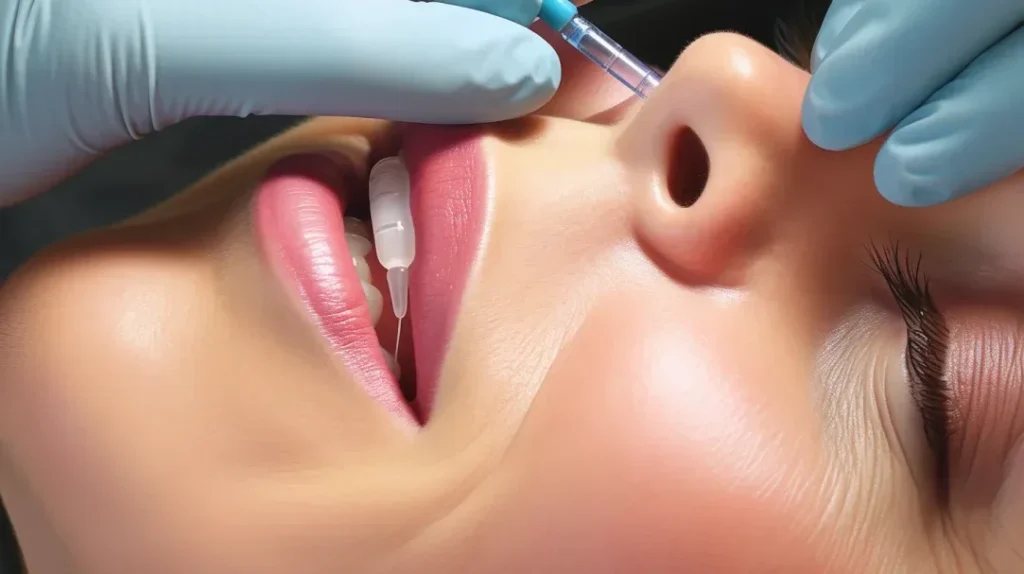Grind No More: Exploring the Benefits of Botox for Teeth Grinding Relief
Are you tired of waking up in pain from grinding your teeth? Say goodbye to the discomfort and hello to relief with Botox.
This emerging trend offers a non-invasive solution for bruxism, reducing symptoms and restoring comfort. In this article, we’ll explore the benefits of Botox for teeth grinding relief.
From the effectiveness of the treatment to the procedure itself, safety considerations, and potential side effects, we’ll provide all the information you need to make an informed decision.
Don’t let bruxism hold you back any longer.
Key Takeaways
- Botox is an emerging trend in dental medicine for treating teeth grinding, showcasing the convergence of cosmetic and therapeutic disciplines in modern dentistry.
- The use of Botox for bruxism reflects a shift towards holistic, patient-centered treatment approaches that consider both the functional and psychological impacts of dental conditions.
- The effectiveness of Botox in reducing symptoms of teeth grinding needs to be analyzed to determine its efficacy as a treatment option.
- When considering Botox for bruxism, patient suitability should be assessed based on specific criteria to ensure the treatment is appropriate and beneficial.
The Effectiveness of Botox for Bruxism
Are you grappling with the discomfort of bruxism? Recent advancements in medical treatments have highlighted Botox as a promising solution. This guide delves into the use of Botox as an innovative therapy for mitigating bruxism symptoms, offering a blend of cutting-edge research and practical insights.
Botox, a well-researched neuromodulator, has gained recognition for its effectiveness in curtailing the habitual grinding of teeth associated with bruxism. By strategically injecting Botox into the masseter muscles, the treatment aims to induce temporary muscle relaxation, thereby hindering excessive jaw clenching and grinding. This approach not only provides immediate relief from the discomfort and pain caused by bruxism but also contributes to the long-term cessation of this involuntary habit.
Moreover, the application of Botox in bruxism therapy aligns with current dental and neurological best practices, emphasizing patient safety and symptom management. Numerous studies corroborate the high success rate of Botox in controlling bruxism, with a significant number of patients reporting marked improvements in their condition.
Incorporating Botox into your bruxism management plan should always involve consultation with a healthcare expert, ensuring that the treatment aligns with your unique needs and health profile. This comprehensive analysis aims to equip you with the necessary knowledge and insights, enhancing your understanding of the evolving role of Botox in contemporary dental and neuromuscular therapies.
The Process of Botox Injections

Now, let’s explore the process of Botox injections for teeth-grinding relief.
These injections involve specific techniques to target the jaw muscles responsible for bruxism.
Injection Techniques for Botox
Dental professionals utilize precise injection techniques targeting specific jaw muscles to administer Botox for teeth-grinding relief. These techniques ensure that the Botox is delivered directly to the muscles responsible for bruxism, providing maximum therapeutic effect. Here are some of the techniques used in Botox application for bruxism:
- Multiple injections: The dentist may strategically administer several tiny injections to target different jaw muscles in teeth grinding.
- Depth control: The injection depth is carefully monitored to ensure accurate placement of the Botox into the targeted muscles.
- Injection angles: The dentist may use different injection angles to reach specific muscles and optimize the effectiveness of the treatment.
- Dosage adjustment: The amount of Botox injected may vary depending on the severity of the bruxism and the individual patient’s needs.
- Follow-up injections: In some cases, additional injections may be required to achieve the desired results.
Following the injection process, the recovery process after Botox for bruxism is relatively quick, with most patients experiencing relief from teeth grinding within a few days. It’s important to note that individual experiences may vary, and it’s advisable to follow any post-treatment instructions provided by the dentist.
Safety and Potential Side Effects
When considering Botox for teeth grinding relief, it’s essential to understand this treatment’s safety and potential side effects. Botox injections for jaw muscles in bruxism are generally safe and well-tolerated. However, as with any medical procedure, specific safety considerations must be remembered.
Here are some potential side effects and safety considerations for Botox in bruxism:
- Temporary muscle weakness or paralysis in the injected area
- Bruising or swelling at the injection site
- Headaches or flu-like symptoms
- Rare allergic reactions or infections
It is crucial to consult with a qualified healthcare professional experienced in administering Botox for dental applications. They’ll ensure that the treatment is performed according to regulatory standards and consider any specific considerations for your dental health.
Criteria for Botox Treatment
Specific eligibility criteria must be considered to determine if Botox treatment for teeth grinding is appropriate for you. These criteria may include the severity and frequency of your symptoms, previous treatment outcomes, and any underlying medical conditions.
Additionally, research has shown that Botox can effectively reduce the symptoms of teeth grinding, such as jaw pain and tooth damage. By meeting the necessary criteria, you may experience relief from your teeth-grinding symptoms through Botox treatment.
Treatment Eligibility Criteria
If you experience chronic teeth grinding, you may wonder if you’re eligible for Botox treatment. To determine if Botox is right for you, here are some criteria that healthcare professionals consider during the pre-treatment evaluation for bruxism Botox:
- The severity of symptoms: The intensity and frequency of teeth-grinding episodes are evaluated to determine if Botox is necessary.
- Failed conservative treatments: If you have already tried other non-invasive treatments, such as night guards or stress management techniques, without success, Botox may be an option.
- Overall health: Your general health and any medical conditions you have will be considered to ensure the safety of the treatment.
- Muscle anatomy: The specific muscles involved in bruxism will be assessed to determine the appropriate dosage and injection sites.
- Patient preference: Your willingness to undergo Botox treatment and your expectations for long-term effects are important considerations.
By evaluating these criteria, healthcare professionals can determine if you’re a suitable candidate for Botox treatment.
Comparing Botox to Other Treatments
When comparing treatments for teeth grinding, it’s essential to assess the efficacy and suitability of Botox and other available options. Here are some key points to consider when comparing Botox to other bruxism treatments:
- Botox and Dental Health: Botox injections target the muscles responsible for teeth grinding, providing relief and reducing the risk of dental damage.
- Comparison of Botox with Other Bruxism Treatments: Botox offers a non-invasive alternative to traditional treatments like night guards or oral splints.
- Dental Considerations in Botox Therapy: Dentists play a crucial role in evaluating patients for Botox treatment, ensuring it’s a safe and suitable option for managing teeth grinding.
- Efficacy and Long-Term Effects: Research suggests that Botox can effectively reduce symptoms of bruxism, with effects lasting for several months.
- Patient Safety and Satisfaction: Many patients report positive experiences with Botox for teeth grinding, experiencing improved quality of life and reduced pain.
Understanding the Mechanism of Botox For Teeth Grinding
Delving into the workings of Botox, particularly botulinum toxin type A, reveals its pivotal role as a muscle relaxant in combating bruxism. This neuromodulator obstructs the release of acetylcholine, a critical neurotransmitter that orchestrates muscle contractions.
When addressing bruxism, a condition characterized by involuntary teeth grinding, Botox is precisely injected into the jaw muscles. This targeted application aims to curtail their hyperactivity. Botox significantly diminishes the severity and occurrence of teeth grinding by inducing relaxation in these muscles. This alleviation extends to common bruxism-related issues such as persistent jaw discomfort, frequent headaches, and potential tooth wear.
The principles behind Botox’s muscle-relaxing capabilities mirror those employed in various dental treatments designed to ease muscle tension and foster overall oral well-being. Grasping how Botox specifically targets and soothes the jaw muscles is essential to fully appreciate its role in offering substantial relief for individuals dealing with bruxism. This detailed understanding underscores Botox’s efficacy as a therapeutic agent in modern dental and neuromuscular care.
Patient Experiences With Botox
Learn about the real-life experiences of patients undergoing Botox treatment for teeth grinding. Here are some patient experiences with Botox:
- Increased comfort: Patients have reported significantly reduced jaw pain and discomfort after receiving Botox injections for teeth grinding. The muscles in the jaw become more relaxed, leading to decreased clenching and grinding.
- Improved sleep: Many patients have noticed improved sleep quality after Botox treatment. With reduced teeth grinding, they wake up feeling more rested and refreshed.
- Long-lasting relief: Botox injections provide long-term relief from teeth grinding. The effects typically last several months, allowing patients to experience sustained benefits.
- Non-invasive approach: Patients appreciate that Botox treatment for teeth grinding is non-invasive. It doesn’t require surgery or the use of oral appliances, making it a convenient and hassle-free solution.
- Positive impact on daily life: Patients have shared how Botox treatment has positively affected their daily lives. They can engage in activities without the fear of jaw pain and enjoy meals without discomfort.
These patient experiences highlight the potential benefits of Botox treatment for grinding teeth, providing relief, and improving overall quality of life.
Long-Term Effects of Botox on Bruxism
Investigating the long-term implications of Botox therapy for bruxism is crucial for comprehending its role in providing prolonged relief from teeth grinding—Botox, known for its muscle-relaxing properties, explicitly targets the jaw tension that frequently triggers bruxism. Through strategic injections into the affected muscles, Botox mitigates the intense muscle contractions responsible for teeth grinding. Scientific studies underscore Botox’s proficiency in significantly reducing the frequency and intensity of bruxism episodes, a development that can immensely benefit one’s dental health. Prolonged teeth grinding, if unaddressed, can result in extensive tooth damage, persistent jaw pain, and recurring headaches.
Furthermore, Botox emerges as a non-surgical alternative to conventional dentistry pain relief methods, such as the use of night guards. This aspect highlights its utility in offering a minimally invasive approach to managing bruxism symptoms. Gaining insights into the long-term effects of Botox for bruxism equips patients with valuable information, aiding them in making well-informed treatment choices.
The following section will delve into the cost-effectiveness of Botox treatment, a critical factor in evaluating its viability as a long-term solution for bruxism.
Cost-Effectiveness of Botox Treatment
Botox treatment for teeth grinding provides a cost-effective solution for managing bruxism symptoms. Here’s why:
- Reduced dental costs: Botox can help prevent dental damage caused by grinding, such as wearing down teeth or fractures, thus saving you from costly dental procedures.
- Minimized medication expenses: By addressing the root cause of bruxism, Botox treatment can reduce the need for pain medications or muscle relaxants, leading to savings in medication expenses.
- Long-lasting effects: Botox injections for bruxism can provide relief for up to 3-6 months, minimizing the need for frequent treatments and resulting in long-term cost savings.
- Improved quality of life: Botox treatment can enhance your overall well-being and productivity by alleviating facial pain related to bruxism, potentially leading to financial benefits in various aspects of life.
- The trend in treating teeth grinding: Botox treatment for bruxism represents a growing trend in dental medicine, highlighting its increasing acceptance as an effective and cost-efficient option for managing this condition.
With its cost-effectiveness and potential long-term benefits, Botox treatment offers a promising solution for individuals seeking relief from teeth grinding.
Post-Treatment Care and Recovery Process
After receiving Botox treatment for teeth grinding (bruxism), proper post-treatment care is crucial for adequate recovery and maximizing the benefits of the procedure. Here are some steps to follow:
- Dietary Adjustments: Avoid chewing hard or tough foods for a few days post-treatment. This helps reduce strain on the jaw muscles as they adjust to the effects of Botox.
- Apply Ice Packs: To alleviate swelling or discomfort, gently apply ice packs to the treated areas. This can provide immediate relief and aid in reducing inflammation.
- Avoid Certain Activities: Immediately after the treatment, it’s advisable to avoid strenuous physical activities and excessive facial muscle movements. This helps the Botox settle into the targeted muscles effectively.
- Follow Custom Treatment Plans: Adhere to any personalized treatment plans your dentist or healthcare provider has outlined. This could include specific exercises, the use of a night guard, or other interventions tailored to your bruxism condition.
- Stress Management: Since stress can be a significant trigger for teeth grinding, incorporating relaxation and stress-reduction techniques into your daily routine can be beneficial. This might include mindfulness, meditation, or yoga.
- Regular Check-ups: Schedule follow-up appointments as recommended. These check-ups allow your healthcare provider to monitor your progress and make any necessary adjustments to your treatment.
- Report Any Concerns: Contact your healthcare provider for guidance if you experience unusual symptoms or prolonged discomfort following the treatment.
- Oral Hygiene: Maintain good oral hygiene practices. While Botox treatment addresses the muscle activity associated with bruxism, protecting your teeth and gums is still essential.
By following these post-treatment care steps, you can ensure a smoother recovery process and improve the effectiveness of your Botox treatment for bruxism.
Frequently Asked Questions
How Long Does It Take to See Results After Receiving Botox Injections for Bruxism?
After receiving Botox injections for bruxism, you may start seeing results within a few days to a week. The effects of Botox can vary, but most people experience relief from teeth grinding within 1-2 weeks.
Can Botox Be Used as a Long-Term Solution for Teeth Grinding, or Is It Just a Temporary Fix?
Botox can provide long-term relief for teeth grinding, not just a temporary fix. It’s like a reset button for your jaw muscles, helping relax and reduce grinding.
Are there any alternative tooth grinding treatments equally effective as Botox?
Yes, there are alternative treatments for teeth grinding that can be equally effective as Botox. Some options include night guards, stress management techniques, and behavior modification therapies. Discuss with your dentist to determine the best treatment for you.
Are Any Specific Factors or Conditions That May Make Someone Ineligible for Botox Treatment for Bruxism?
You might be surprised to learn that there are very few factors or conditions that would make someone ineligible for Botox treatment for bruxism. It’s a safe and effective option for many people.
How Does Botox Compare to Night Guards or Other Dental Devices in Terms of Effectiveness and Convenience for Treating Teeth Grinding?
Botox is a more convenient and effective teeth-grinding treatment than night guards or other dental devices. It provides relief by targeting the muscles responsible for grinding, offering a non-invasive solution for managing this condition.
Conclusion
In conclusion, Botox offers a promising solution for teeth-grinding patients.
Like a gentle breeze sweeping away the clouds, Botox alleviates symptoms and relieves the discomfort and pain of bruxism.
With its effectiveness in reducing grinding, minimal side effects, and comparative analysis against other treatments, Botox is a safe and viable option.
So, say goodbye to jaw pain and headaches and embrace a future free from the clenching grip of teeth grinding.

